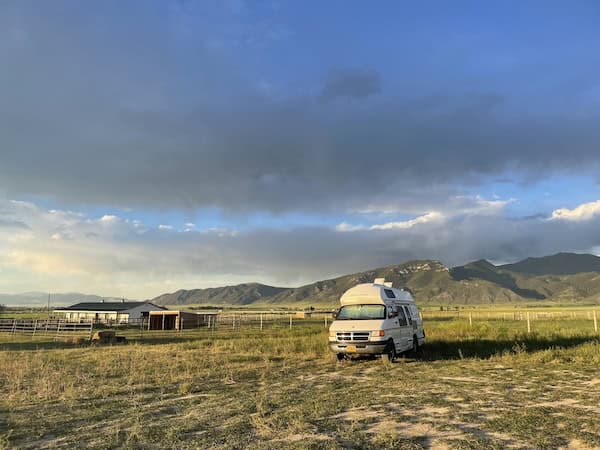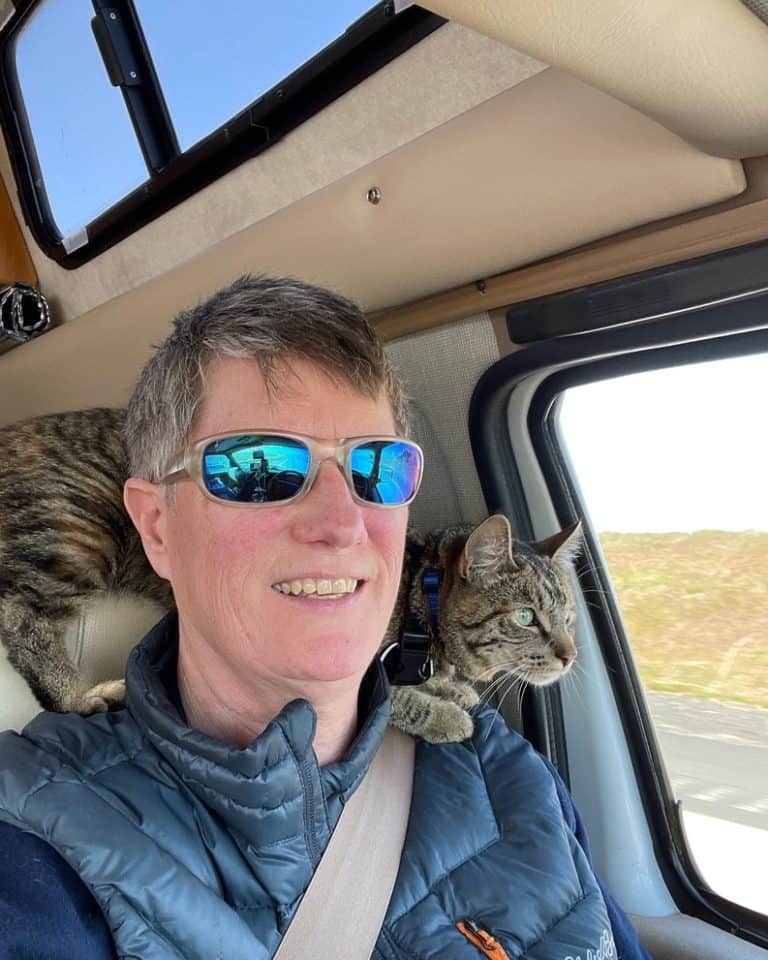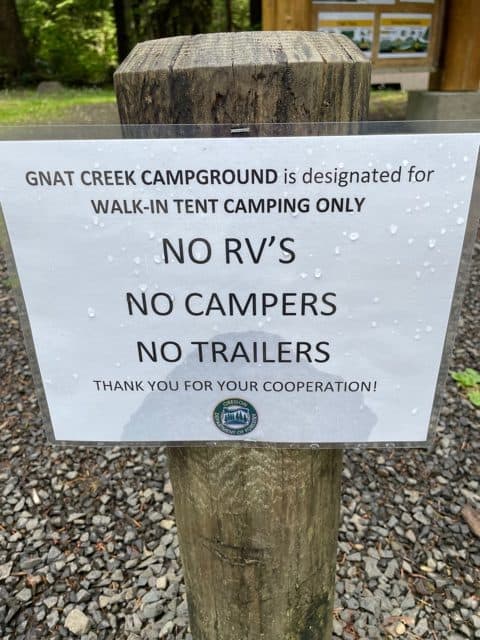RVing with a Cat: the Ultimate Guide
Solo Women RV contains affiliate links and participates in the Amazon Services LLC Associates Program. If you make a purchase using one of these links, I may make a commission at no extra cost to you. Thank you for your support.
Can you RV with a cat? Absolutely! I’ve been RVing with my cat Tucker since I got her as a 9 week old kitten. Of course, RVing with a cat takes preparation and not every cat may be suited for RV travel, but with proper planning and patience, you can take your cat or kitten on RV adventures.
RVing with a cat can be a ton of fun for both you and your cat. Exposing them to new environments can be stimulating for them, but also stressful. Make sure you and your pet are prepared to hit the road together.
Preparing to RV with a Cat
The first thing you’ll want to do is get your cat used to the RV. While it’s parked in your driveway, spend time in there with your cat. Make it as inviting as possible. Feed her in the RV. Bring some of her favorite treats, toys and bed.
When I first got Tucker, I brought my laptop into the RV in my driveway and worked from in there. I had her bed, where she took naps. I put a litter box in the RV right away and let her know it was there. I got some toys that were just for the van and left them in there for her. I also got some cat treats and only gave her treats in the van, not in the house.
You can do the same with canned food, a special toy or cat nip. Make the RV an appealing place for your cat and one where she wants to be.
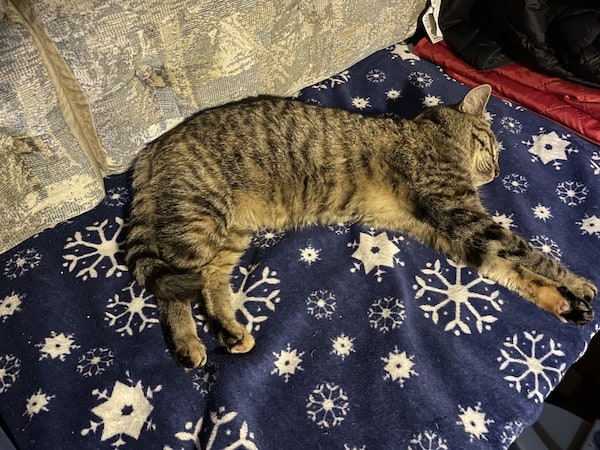
Prepare Your Cat for Adventuring
In addition to getting your cat used to the RV, you’ll also want to get your cat ready to be an adventure kitty. This means preparing your cat to come with you on walks or hang out with you in the campground. If your cat is an indoor only cat, you’ll have to decide if she will remain an indoor cat while RV traveling. If you travel in a big Class A or Fifth Wheel, keeping your cat an indoor-only cat might be feasible. But if you travel in a smaller RV, it might be a good idea to train your cat to go outside—whether on a leash or in a cat-safe environment.
To gradually get an indoor kitty used to the outdoors, take her out in short, safe chunks. A cat-specific outdoor playpen, such as this. Never leave your cat unattended in one of these. Sit outside with them, while they watch the birds and squirrels from the safety of your yard or nearby park. Be sure to keep dogs away, as this might scare the cat.
If your cat loves the playpen, you might consider only allowing your cat inside after a ride in the RV as a reward for the travel.
Getting Your Cat Used to a Harness and Leash
In order to take your cat RVing, you’ll want to get them used to being in a harness and leash. Since I got Tucker when she was just a kitten, the very first thing I did when I picked her up was put her in a harness. I attached the leash and let her wander a bit before I even put her in the RV to bring her home.The younger you can start, the better, but that does not mean you can’t teach an older cat to get used to a harness and leash.
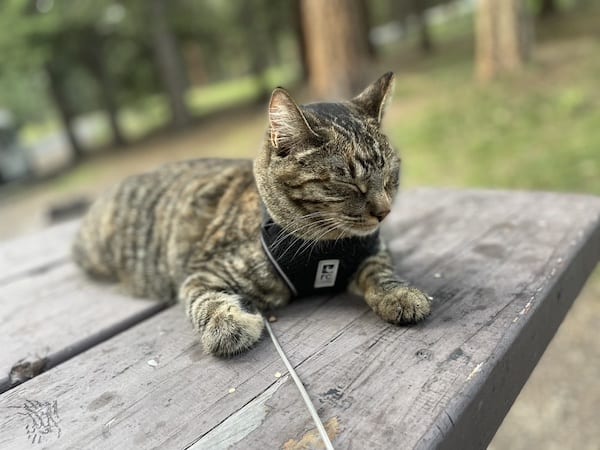
Try just putting a harness on and letting your cat get used to it in the house. Give her treats and if she’s struggling or trying to get it off, try to distract her by playing with her favorite toy. Leave it on for a short period of time and then take it off. Gradually increase the time in the harness.
Next you’ll want to attach the leash and let them lead you around with a loose lead. Do this for short periods of time to allow your cat to get used to the leash and also you following them around. After she gets used to this, gently pull on the leash to try to lead her in a different direction. Throw treats down if she won’t follow.
Next you’ll want to get your cat used to being outside. With the leash and harness on, open the door and entice them out with a treat or something to chase. Start slowly and don’t force your cat to do anything that scares her. It’s important to create confidence and fun each step of the way to acclimating your cat to harness, leash and outdoors.
Personally, I like having a small flexi-leash for my cat. It allows her to explore a bit away from me and even allows her to safely climb trees.
Walking a cat on a leash is not like walking a dog. More often, you will be following them around, rather than leading them on a walk or hike. Regardless, it will be nice to have a cat that you can take outside of your RV for short walks around the campground or even to just tether to your chair while sitting around a campfire.
Tip: Get a cat specific harness and not a dog harness.
Prepare Your Cat for Driving Days in Your RV
Not a lot of cats love being in a moving vehicle. For many people, preparing your cat for driving will be the most challenging part of RVing with a cat. I picked Tucker up when she was only 9 weeks old. The people I got her from drove two days to bring her to me. She was a natural in the car and took to it pretty well.
Herbie, the cat I had before Tucker HATED the car. She would cry and cry and pee herself just on short trips to the vet. The motion of car travel is something most cats need time to get used to. Don’t expect your cat to hop in the RV and be ready for a 10-12 hour drive. Start short and slow.
If your cat gets anxious, a product like Feliway may help her feel more comfortable.
Take your cat on very short trips to get them used to traveling in your RV. Like really short. Around the block is a good start. Gradually increase the distance and each time reward your cat with the things he loves, whether it be pets, treats, catnip or wet food.
If your cat is used to a carrier, you might want to plan to put them in that before you drive. For Tucker, I use a backpack, instead of a hard sided carrier. We use it for short walks and also it’s her safe space.
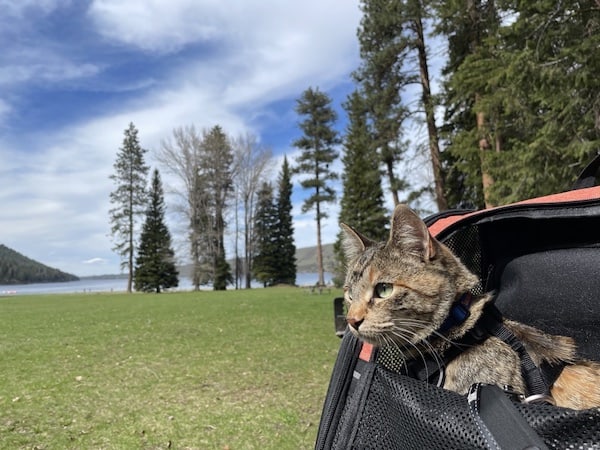
Where will Your Cat Ride in the RV?
You will need to decide if you are going to let your cat free roam or be confined during RV travel days. I’ve let Tucker loose in the RV when I’m driving, and although I know it might not be the safest if we are in an accident, she is happy to move from my lap to her carrier to top of the fridge and it makes travel days less stressful for her.
It is definitely safer to keep your cat enclosed in a hard sided carrier that is strapped in. If your cat will tolerate that, I recommend it. Again, start with short trips with your cat in the carrier so she can get used to it.
If you have a tow behind trailer, I recommend keeping your cat in the tow vehicle with you while you drive. You will be unable to monitor your cat while they ride in the back. Keep your cat secure in a travel crate, something that can be secured in case of accident, but also something that is cozy that your cat will want to retreat to.
Cats in RVs: Your First Camping Trip with Your Cats
Now that you have your cat used to the harness, leash and driving, it’s time to go on your first RV camping trip with your cat. Your first time camping your cat should be short, local and the primary purpose to get your cat used to camping. Don’t plan to meet up with a bunch of friends who have dogs and kids. Try to pick a local favorite campground where you can control the environment as much as possible. Make sure the campground allows pets. Try to plan for a day with good weather.
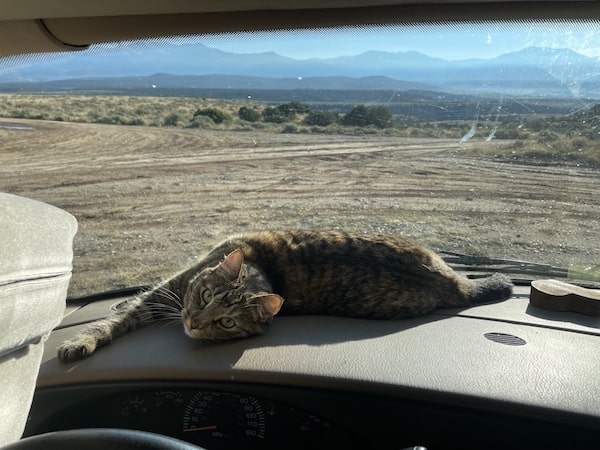
Arrive at your spot and before you set up, let your cat out to smell and take in the surroundings. Take her out on her leash and let her smell the smells and see the sights. If she starts to get scared, take her back inside. Remember, you want this to be a positive experience for your cat, so don’t push her to do things she is not ready for.
If she seems scared or skittish, take it slow and expose her in short bits. Always encourage and give positive reinforcement and treats. This will be a time for you to observe your cat to see what he likes and doesn’t like. I found out my cat loves to be near bushes, so she can hunt for little critters and watch the birds. I also learned she is afraid of the ocean, but likes wooded trails. I also learned to always take Tucker’s backpack with me, because it is her safe haven when she gets scared. She can go inside when she gets overwhelmed or scared.
Tip: Learn about cat body language
Where to Put the Litter Box in an RV?
Since I travel solo, I have Tucker’s litter box under the front passenger seat in my van. This has the added benefit of making it easy to access for cleaning because I can just open the side door and scoop from outside. When I have a passenger, I move the box to the back of the van while we’re driving and then put it back under the seat when we stop for the night.
Where else can you put a litter box in an RV? You can put it in the bathroom or specifically in the shower. Note: Don’t scoop litter in your black tank. Black tanks are made for human waste, not the kinds of organic and chemical materials found in litter.
You can make space for a litter box under a bench or cabinet and add a kitty door. Some have removed their dinette and created a cubby space for their cat. All RVs have different layouts and come in different sizes. Experiment with what works for you and your particular set up.
What Kind of Litter Should You Use in an RV?
The brand of litter you use in your RV is not as important as you making sure it is unscented and low tracking. Because your RV is small, confined space, scented kitty litter will quickly overpower your RV. I found that out the hard way.
I also found out the hard way that lightweight litter is not necessarily better. The important thing to consider is low-tracking. That way your cat won’t be tracking litter all over your RV. This is the kind I use: Arm & Hammer Super Scoop Fragrance Free
I prefer clumping litter, as it makes scooping smelly urine easy. I keep doggy poop bags near the litter box so I can scoop whenever she goes. Simply scoop into the dog bad and deposit into the outside trash as soon as she goes.
Food and Water for RV Cat
As you head out for your first camping with cat adventure, so much is new and different for them. This is not a time to change their food or water. Try to keep their feeding schedule the same as when in your home. Find a spot where they have easy access to their food where you won’t be kicking it all the time. (Again, learned this the hard way.)
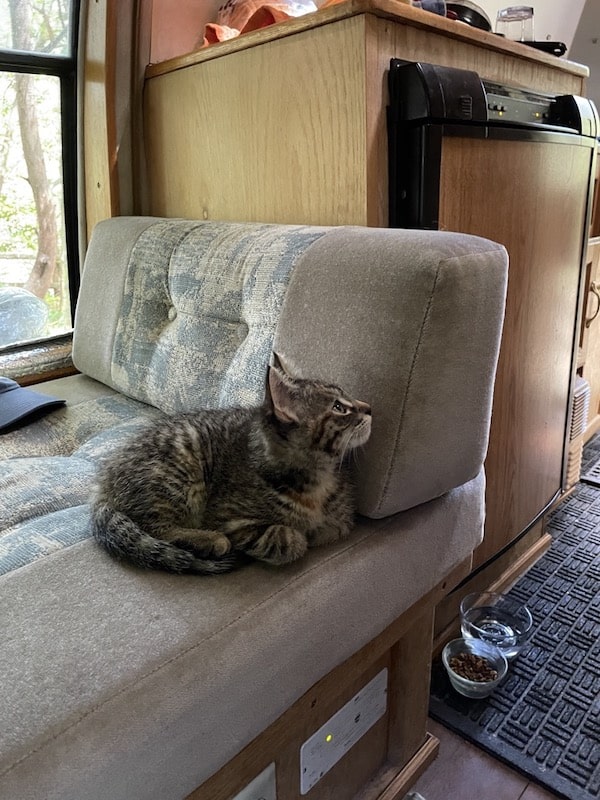
Tip: Bring a bottle of water from home. Cats can be finicky about water, so bring along some water they are familiar with to encourage them to drink in a new and potentially stressful environment.
Create a Comfortable Spot for Your Cat in the RV
It’s no secret that cats love to be up off the floor. A cat will feel safer in a spot that’s elevated, so make sure your cat has a nice bed or comfortable place to hang out that is up off the ground. I had a cat bed for a while on the passenger seat, but Tucker preferred to hide away in her backpack, so I eventually got rid of the bed. This is the backpack we use.
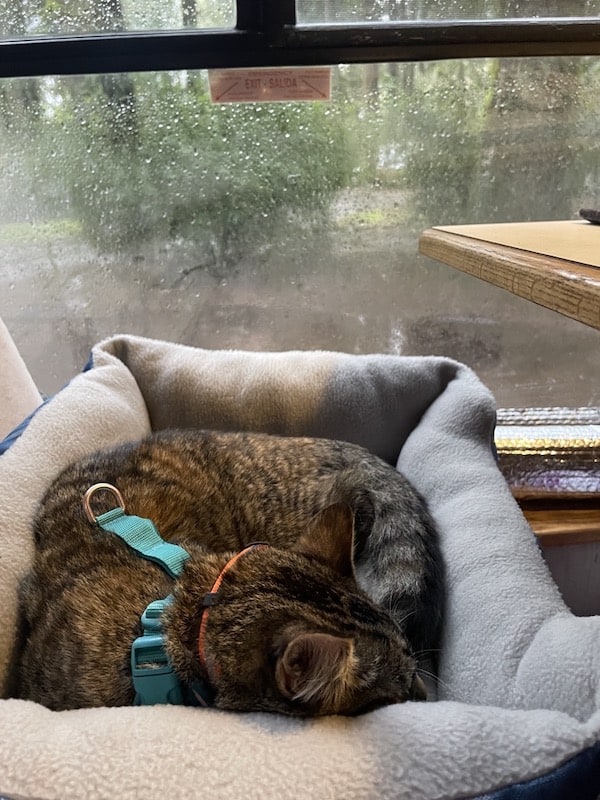
Keeping Your Cat Cool
Your pet’s safety is a big concern while on the road. While RVs do not heat up as quickly as cars do, leaving your pet unattended in a hot vehicle can be dangerous. It’s important to know the temperature inside your RV when you’re not around. Cats can overheat and get heat stroke.
Most RVs come with fans and air conditioners to keep them cool in hot weather. Most air conditioners cannot run unless you are plugged into shore power. With a cat’s ability to escape, you really can’t keep your windows down. A fan, such as an Air max or a portable rechargeable fan, such as this one are great options for days when you are not plugged into shore power and you need to leave your cats behind to hike or sightsee, or even for travel days, when you stop at a store for groceries.
But more than just leaving a fan or RV running and trusting it’s going to keep your RV cool, you need to actually monitor the temperature inside your RV. That’s why I travel with a Waggle. Waggle is a device that monitors the temperature inside your RV, and sends you a text alert when the temperature gets too hot or too cold, so you can return to your RV and make sure your pet is safe.
A few caveats about the Waggle. Once you buy the device, it does require a yearly subscription. Also, you need to be in cell phone range for it to send you an alert. Keep that in mind when you leave your pet behind.
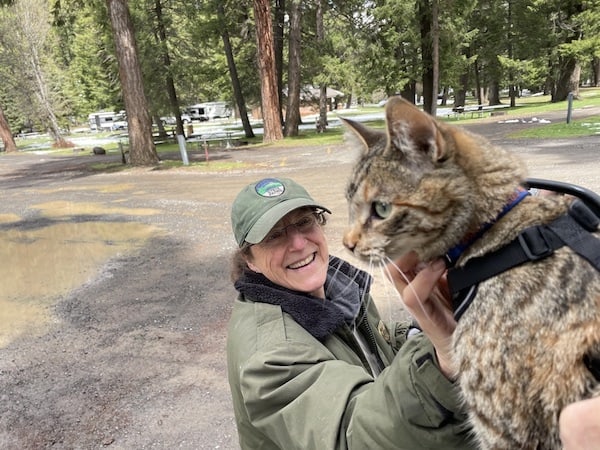
Cats in RVs: When You Need to Leave Your Cat Behind
There will be some times when you are traveling to a place where your cat is not allowed and you might want to find alternative arrangements for them. While dog kennels can often be found at the entrances to national parks—where pets are not allowed on most trails—you most likely don’t want to leave your cat in a dog kennel. Even if they did take her, she might get totally freaked out.
When I’ve had to leave Tucker behind I’ve found amazing in-home pet sitters via Rover. The first time was when I attended a concert in the Gorge, where RV camping is allowed, but pets are not. The other was when I went to Glacier National Park with my brother.
Before I booked a sitter, I made sure to read their reviews, make sure they took cats, that they would have a safe place for her and that she wouldn’t be able to escape. It wasn’t necessarily cheap, but for the peace of mind, it was worth it. The sitters kept me up to date with reports and photos of Tucker, so I knew she was in good hands.
How to Keep Your Cat from Escaping the RV
A big part of keeping your cat safe is to make sure he doesn’t escape the RV when you don’t want him to. Until you get to know your cat’s behavior on the road, and even after you do, there is always the chance your cat might escape. You should have a plan to keep your cat from escaping, but also have a plan for what to do in the event that they do escape.
Whenever you arrive at a new campsite, be sure your cat is secure before you start to set up. Put your cat in their crate or backpack or even close them in the bathroom for a (very) short period of time.
Make sure doors and windows in the RV are closed. Cats can squeeze out pretty small spots if they’re motivated. One particularly hot night, Tucker climbed out an open window in my RV. Luckily, after I noticed, when I opened the door to look for her, she was waiting for me at the door.
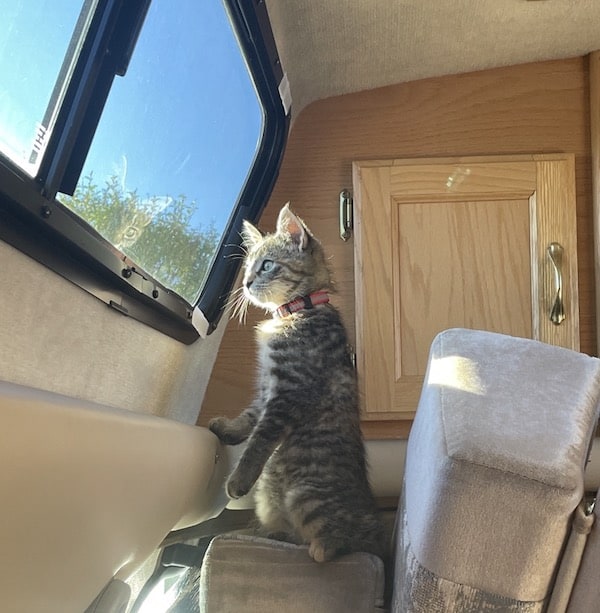
If your cat is the type who lurks close to the door to try to make an escape every time you open the RV door, be prepared each time you open the door to intercept your cat first thing. I make it a point not to have anything in my hand when I first come back to my RV after being away for a while, in case Tucker tries to dart out, I can grab her.
I have my cat trained to hang outside the RV with a harness and small dog tie out. Whenever I get to a new spot, I hook Tucker to her leash and let her walk around a bit to smell the new environment. Then I put her on her tie out while I hook up the RV and get set up.
What to do if Your Cat Escapes the RV
Cats can be trained, so before you head out with your cat on an RV trip, work on training her to come when she is called. Cats are not as reliable as dogs at coming, but most will eventually come home, unless they get lost, are hurt or are spooked.
Cats can be trained to come if you give them treats. I give my cat a treat every time she comes inside the RV. I also shake a jar of treats, so she associates that noise with treat time and she comes running to get one.
If your cat likes to chase a laser toy, that can also be an incentive to lead them into your RV.
Here’s a great video about training your cat to come.
Always get your cat chipped from a service like Home Again and have a collar with an ID tag, or better yet your phone number stitched right on the collar. This is the collar I use for Tucker: It’s pretty inexpensive and I usually buy a few at a time, because she does lose them.
- You might also consider at Cat GPS device such as Tractive GPS tracker for cats.
- Or a radio tracker
- Or a Bluetooth tracker
Each of these has their advantages and disadvantages, you can read more about them here: https://allaboutcats.com/best-cat-tracker
I ended up with the radio tracker, because I liked the accuracy and the fact that you don’t need a monthly subscription.
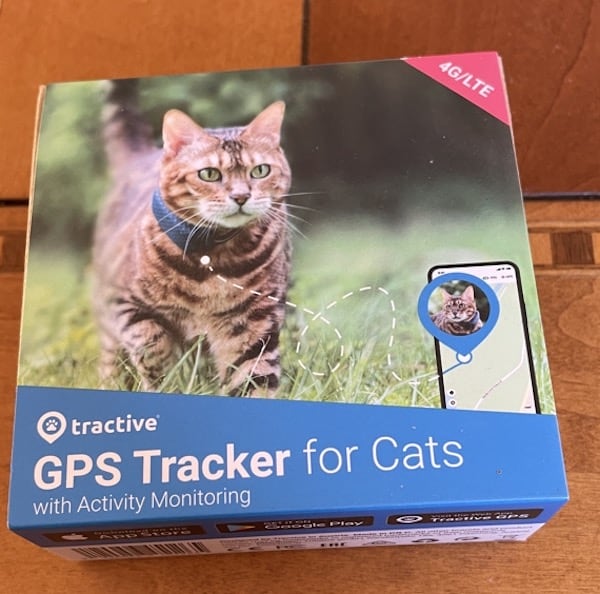
Plan for Fun RVing with a Cat
Taking your cat camping may give you peace of mind, but make sure you spend time with your cat doing the things she loves. Play with her extra. Cuddle and feed her favorite food. Bring some catnip along and set up a spot where she can look outside and watch the birds.
Take her on walks. Tucker loves to climb trees. Your cat might like sitting in a chair near the campfire. Set her up in a tent or take her for a walk in a kitty stroller. Let your cat show you what she likes and doesn’t like and make sure to make the experience enjoyable for her.
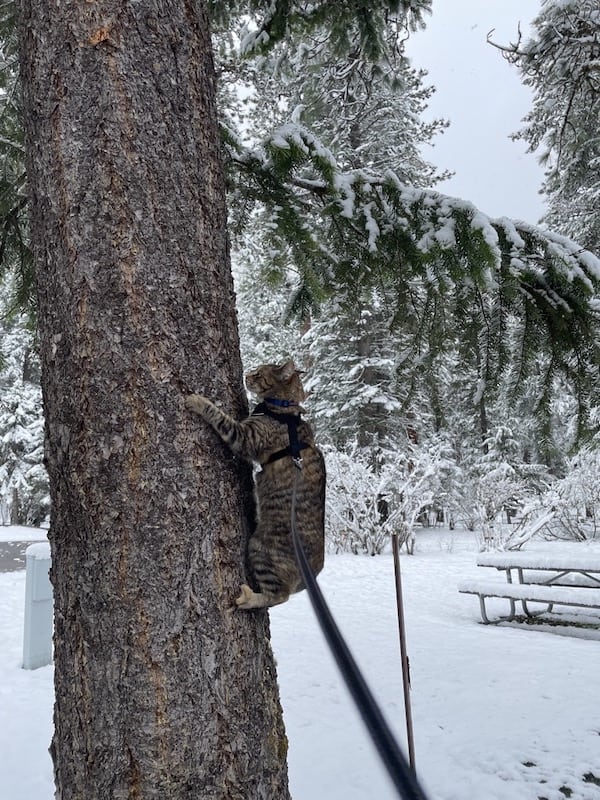
Dangers of RVing with a Cat
While RVing with your cat, it’s important to aware of some of the dangers that are not present when you’re at home. We already talked about your cat getting out and getting lost and being prepared for that.
Wild and domestic animals can also be a danger while camping with your cat or RVing with cats. One of the things we love most about RVing is being out in nature. It’s important to be aware of the kinds of predators that might view your cat as prey. Coyotes are a danger most places, even in urban settings. Unfortunately, many dog owners do not obey leash laws and a dog could chase your cat, injuring him or causing him to run away and get lost.
Foxes, raccoons, bears, cougar, owls, hawks, eagles and snakes can all see your cat as prey. Be aware of your surroundings and keep any eye on your cat at all times.
Plan for an Emergency RVing with your Cat
If our cat becomes ill or hurt while traveling, will you be prepared? Be sure to learn some basic pet first aid, especially if you will be traveling to remote areas. The Red Cross offers a Cat & Dog First Aid Class online.
Make sure you have some money set aside to pay for unexpected medical bills. I had to take Tucker to the animal urgent care the other day because she was acting listless and not eating. A simple exam, some fluids and appetite enhancer cost me $254. I pulled out the credit card without blinking.
What if your pet got hurt and needed thousands of dollars worth of care? Would you be able to afford it? You might want to consider pet insurance. Be sure to do your research before getting pet insurance to make sure you know what is covered, what is not and what your deductible and co-pays will be.
Bonus FAQ: RVing with Cats
Do Cats travel well in an RV?
Most cats will eventually adjust to traveling well in an RV, but it’s important to go slow and give your pet time to adapt. Incorporate things into your RV that make it feel homey and comfortable for your cat: a bed, a litter box, catnip toys, snuggly blankets and even a cat cave, for them to hide in.
How can I live in an RV full-time with a cat?
If you’re ready to take the plunge into full-time RV living, yes, you can take your cat with you! Living full time in an RV with a cat is not that different than traveling with your cat in an RV. If your cat doesn’t like driving days, full time RV travel may be preferable to him, because you will likely spend more time in one place when you live in your RV full time.
Just like at home, it’s important for your cat to have stimulation and a way to let off energy. Make sure to take time to play with your cat and if they like going outside, get a harness and a leash and an outdoor play area. You might even consider building a custom catio for your RV. I’ve seen some great ones out there.
How do you calm a cat in an RV?
Some cats will be naturally anxious in a moving vehicle. Some may have a harder time getting used to travel days. Make sure that your cat has a place to where she feels safe and secure while you are driving. Look for the places your cat gravitates toward when she is stressed and try to create a comfortable spot there. Is it top of your bed, under the covers, behind a cupboard or simply in her crate or backpack? Put some bedding down and something with your smell to put your cat at ease.
Some cats may feel more comfortable with a towel draped over their crate. Others might want to look out the window. Observe your cat and determine what form of travel they like best.
A product such as Feliway can help calm your cat in stressful situations. Feliway is vet-recommended and mimics a cat’s natural facial pheromones, which may help your pet feel calmer on travel days or if you have to leave her behind. I use this on travel days with Tucker to make her less stressed out.
Conclusion: RVing with Cats
Remember, cats can make great camping and RV companions if you take the time and make sure you’re both prepared. Here are some products I recommend to make RVing more enjoyable for you and your cat:
Products for RVing with Cats:
- Tiny Tent These tiny tents are not only cute, they’re a great way to create a safe hiding spot for your cat to hang out.
Make sure you have some place for your cat to scratch, otherwise your upholstery will get shredded! Something simple like this scratching post is ideal for an RV:
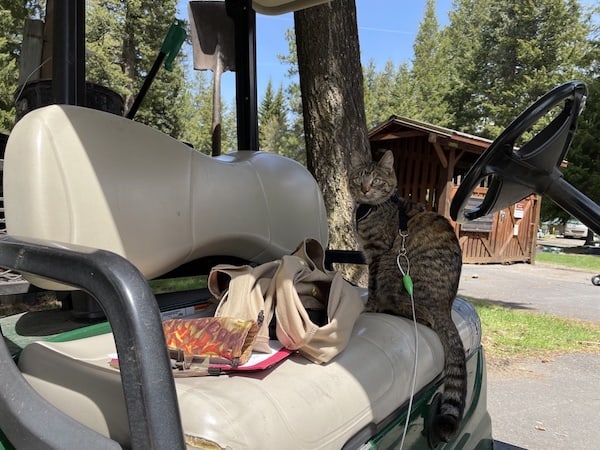
More About Camping with Cats and Dogs and Other Pets:
- Listen to my interview with Nancy about Camping with her Cat
- Listen to my interview with a pet trainer about camping and pet etiquette
Disclosure: This post contains affiliate links, which means I may get a commission if you decide to make a purchase via my links.



